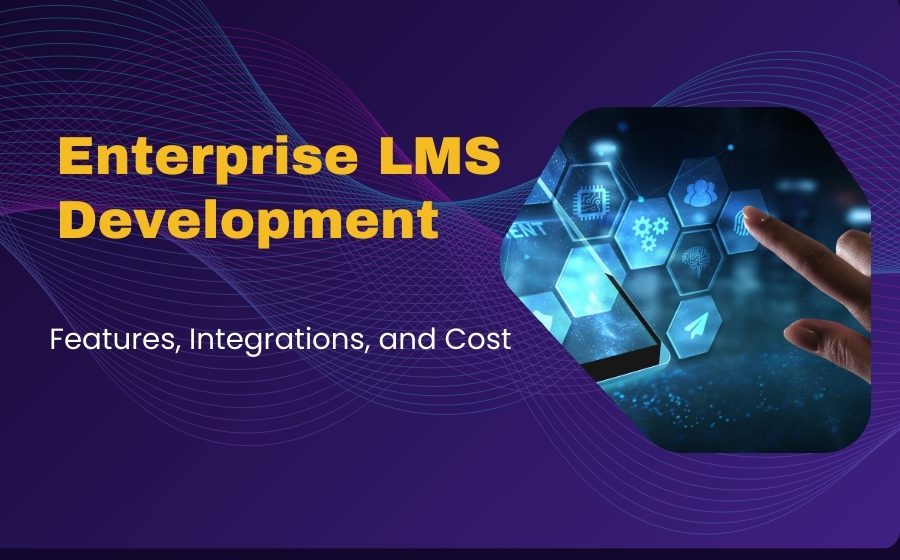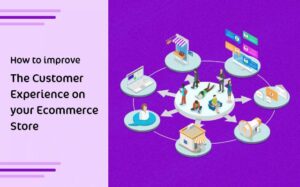Learning Management Systems (LMS) are crucial for enterprises and educational institutions. These platforms help organize and deliver training, manage compliance, and distribute learning materials efficiently. Whether for employees, students, or stakeholders, an LMS ensures that content is easy to access and manage, streamlining the learning process across the organization.
This article provides a clear guide to developing a custom enterprise LMS. It covers key features, the development process, and a breakdown of costs to help businesses build a secure, tailored LMS that fits their needs.
Overview of Enterprise LMS and Its Importance
An enterprise LMS is an advanced system that allows companies to organize all activities related to training, compliance, and career development of their employees. Such systems enable organizations to offer training, monitoring the advancement of their employees and determining whether training has been done in accordance with the law.
The demand for custom LMS solutions has increased because of globalization and the need for e-learning in all sectors. More and more corporate companies are looking for specialized solutions that serve their unique needs. Industries like healthcare, finance, IT, and education are some that use LMS platforms to improve training and compliance.
For a better understanding, consider the following example: An illness management system integrates an LMS to ensure regular updates on compliance for its employees. A financial institution will have training for the workforce, especially on new policies. In the case of IT companies, continuing education is the main element in workforce management.
Essential Features of an Enterprise LMS
To create an effective LMS, several critical features must be incorporated. These features enhance the user experience, streamline learning, and ensure successful implementation.
User Management and Roles
A good Learning Management System (LMS) ensures proper management of users by providing for user roles and permissions. An administrator, instructor, or learner can view or access certain materials according to their roles to promote security in the learning offered.
Course Management
The LMS should provide the ability to create, upload, and manage training content. This entails functionality for tests and examinations such as quizzes to test the knowledge acquired by the learner.
Gamification
Incorporating elements of gaming, for example, the use of rewards and rank orders, increases the interaction of the user. Features for tracking progress according to the users’ current status are excellent and very satisfying.
Interactive Learning Tools
A good Learning Management System has different interactive learning tools like discussion boards, chats, and webinars. Such tools encourage partnership and make the learning process more enjoyable.
Mobile Learning
Support for mobile devices is crucial. It allows learners to access content on-the-go, making training more flexible and convenient.
Assessment and Certification
The LMS should include tools for conducting quizzes and tracking performance. Issuing certificates of completion recognizes learner achievements and motivates continued engagement.
Reporting and Analytics
Data dashboards and custom reports are essential for monitoring learner progress and engagement. This data is critical as it enables the organization to understand its weaknesses and problems.
Multi-Language and Localization Support
For international corporations, LMS should ensure localization along with multilingual options. This ensures that any teams involved in the project can take full advantage of the learning facilities offered.
SCORM and xAPI Compliance
Compliance with globally accepted content standards is very important. This facilitates the sharing of the training content across different use cases, making the training programs more efficient.
Key Integrations for an Enterprise LMS
Integrating an LMS with existing systems is essential for maximizing efficiency. Here are some critical integrations to consider:
HR and Payroll Systems
Linking up with HR applications such as Workday or BambooHR makes it easier for the employees to go through training or even onboarding processes.
Customer Relationship Management (CRM)
It is advantageous to use systems such as Salesforce to monitor and evaluate the client training programs. It gives an assurance that the client-serving staff are adequately informed in regard to serving the clients.
eCommerce Integration
For organizations that sell courses, integrating eCommerce platforms such as Shopify and WooCommerce increases the chances of profitability. This allows organizations to manage subscriptions or certifications using the LMS itself rather than reverting to other tools.
Video Conferencing Tools
Installing video conferencing tools like Zoom and Microsoft Teams also brings live sessions and webinars. This supports the learning process since interaction takes place in real time.
Single Sign-On (SSO)
Incorporation with the internal corporate system facilitates a safe, easy and nice way of identifying users. This enhances the user experience by simplifying access to the LMS.
Learning Experience Platform (LXP)
Providing links with LXP tools helps to create assorted learning paths and content suggestions that match different learners. This is a way of enhancing adaptive learning approaches for specific learners.
Third-Party API Integration
The capabilities of the LMS system can also be improved by integration of support for other platforms, such as LMS email marketing platforms and collaboration tools.
Development Process for a Custom Enterprise LMS
Creating a custom LMS involves several essential steps. Each step is crucial for building a platform that meets the specific needs of an enterprise.
Step 1: Requirements Gathering and Planning
Start by understanding the specific needs of the enterprise. Identify learner demographics and compliance requirements to inform the development process.
Step 2: Choosing the Tech Stack
Select the appropriate backend development tools like Node.js or Django, and frontend development frameworks like React or Angular. Choose a database like MySQL or PostgreSQL to manage content, users, and course data.
Step 3: UI/UX Design
Design a user-friendly and intuitive interface for all users. Focus on creating an engaging learning environment that is easy to navigate.
Step 4: Core LMS Development
Build core features, such as user management and course management. Integrate content standards like SCORM or xAPI for seamless content sharing.
Step 5: Integration of Third-Party Tools
Integrate necessary external tools, including HR systems and video conferencing platforms, to enhance the LMS’s functionality.
Step 6: Testing and Quality Assurance
Conduct thorough testing for performance, security, and usability across all devices. This step ensures a smooth user experience upon launch.
Step 7: Launch and Ongoing Maintenance
Once testing is complete, launch the platform. Provide ongoing updates, feature additions, and security patches to keep the LMS up-to-date.
Cost Breakdown for Developing an Enterprise LMS
It is important to know custom LMS software development costs in order to plan a budget. There are many factors that affect the cost in general.
Factors Influencing the Cost
- Feature Complexity: Factors such as the number of features, advanced analytics, gamification, etc. affect the costs considerably.
- Integrations: Integration of third-party tools increases the cost.
- Customization: A completely custom solution would be more costly than ready-made solutions.
- Compliance and Security: Ensuring compliance with data protection laws and implementing security measures adds to the overall cost.
Estimated Development Costs
- Basic LMS: A basic LMS can be developed from a range of $30,000 to $70,000. This includes only basic functions such as course management and user roles.
- Advanced LMS: An advanced LMS can range from $100,000 and can go as high as it’s complexity. This includes the constructive development of advanced analytics mobile-friendly applications along with the compliance features.
Ongoing Costs
- Hosting and Infrastructure: Costs for utilizing cloud services on a monthly subscription basis may fall within the range of $2,000 to $5,000.
- Maintenance and Updates: Regular updates, feature additions, and security patches will incur additional ongoing costs.
Benefits of Custom Enterprise LMS Development
Investing in custom LMS solutions provides numerous advantages for businesses.
- Tailored to Business Needs: Custom development allows for features specific to your industry and organization.
- Improved Learner Engagement: Personalized learning paths and interactive tools can increase engagement and retention.
- Data Security: A custom LMS ensures that sensitive employee or learner data is protected with top-tier security measures.
- Scalability: A custom LMS can grow with your organization, accommodating new users and content without performance issues.
- Integration Flexibility: Seamlessly integrate with existing tools and systems for smoother operations.
Why Choose Esferasoft for LMS Development?
Esferasoft is known as a leading LMS development company specializing in custom LMS solutions. With more than 17 years of experience in developing customized LMS platforms for enterprises, they understand the unique challenges organizations face.
The company emphasizes expertise in the latest technologies and security protocols. They have a proven track record of successful projects across diverse sectors. Esferasoft offers comprehensive services, from consultation to development and ongoing support, ensuring a smooth journey from concept to implementation.
- Expertise and Experience: Esferasoft features a skilled team with over 17 years of experience in the industry. They ensure LMS solutions according to your needs.
- Customized Approach: They focus on understanding client goals and delivering personalized LMS solutions that align perfectly with organizational objectives and workflows.
- Ongoing Support and Maintenance: Post-launch, Esferasoft offers continuous support and maintenance, ensuring optimal performance and user satisfaction through regular updates and issue resolution.
- Focus on Innovation: Esferasoft stays current with industry trends, integrating innovative technologies and features to enhance learning experiences and keep clients competitive.
Conclusion
Developing an enterprise LMS from scratch can be time and resource-consuming, however, it can significantly change the training and development within an organization. A custom LMS makes the learners more involved in the process, reduces the hassles of various procedures, and gives a proper picture of the learner’s progress. With the knowledge of critical aspects like features, integrations, and the development process, businesses can come up with a suitable solution for their requirements.
With the right web development partner like Esferasoft, it’s possible for businesses to embrace an advanced learning management system and bring positive learning outcomes to the organization. In this era, where technology is constantly evolving, it equally becomes important to project a strong LMS system in building a competitive edge and enhancing organizational learning.
FAQs
How long does it take to develop a custom LMS?
The development time varies based on complexity but typically ranges from a few months to a year.
What are the key features of an enterprise LMS?
Essential features include user management, course management, gamification, and reporting tools.
What is the cost of maintaining an LMS after development?
Ongoing costs include hosting, maintenance, and updates, averaging between $2,000 and $5,000 monthly.
How does a custom LMS integrate with existing systems like HR software?
Custom LMS can be integrated with HR systems through APIs, streamlining training and onboarding processes.
Is custom LMS development scalable?
Yes, custom LMS can grow with your organization, accommodating new users and content without issues.










